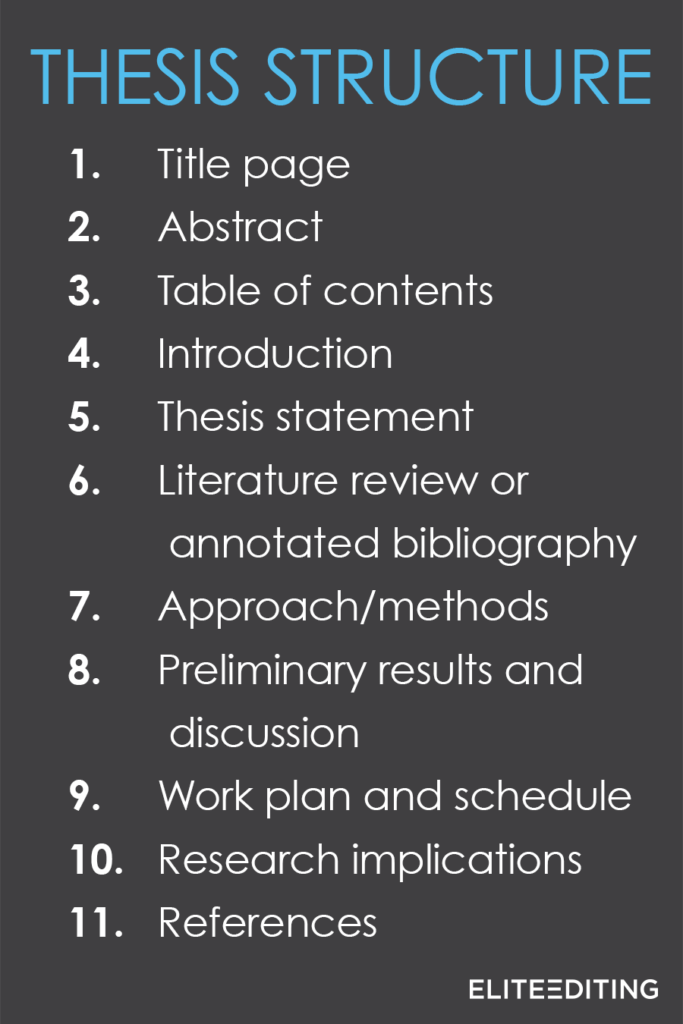If you want to build a house, step one is not wandering over to the next vacant lot with a hammer, some nails, and a pile of boards. Your first step is probably finding an appealing place to build your house—an empty plot of land where the roads are good and where you can pretty easily connect the gas, electricity, and water. Step two is drawing up a blueprint for what you plan to build.
If a thesis is a house, then a thesis proposal is your blueprint. It’s you figuring out how your thesis will fit into the space you’ve found, how you’ll build it, and whether it will stand up to the harsh winds of your thesis adviser’s opinions and the tremors of a difficult defense. A thesis proposal allows you to clearly define—and even more crucially, limit—the focus and scope of your research. Producing an excellent thesis blueprint means that you won’t accidentally find you’re trying to build a skyscraper when you should be aiming at a bungalow—and that you have all the supplies and equipment you need.
But how do you create a research proposal? How do you know what it should include? The style and length of your thesis proposal will vary a bit depending on your school’s requirements and the type of thesis you will eventually produce, but the fundamentals will always be the same, and those are what we’re going to cover here. So let’s look at how to write a thesis proposal.
Choosing a Topic
The first step (a step that you must take before figuring out how to write a thesis proposal or even a thesis proposal outline) is choosing a topic for your thesis. The point of embarking on this kind of project is that you’ll first find and then fill a gap in the established, preexisting research in your field. You’re looking for a manageable topic—something focused enough that you can cover it within your word limit but broad enough that you actually have something to write about.
Undergraduate theses are often less revolutionary and more about surveying or analyzing the existing research on a particular topic. This is appropriate because these projects are shorter in length—and you have much less time (typically months rather than years) to work on them. An undergraduate thesis can run anywhere from ten to thirty pages. A master’s thesis is typically forty to eighty pages and might present some original research, or it might be a significant reinterpretation of preexisting research.
A doctoral thesis is (naturally) the longest of these three, and the research it presents should be more groundbreaking and challenging to complete. That investment of time and mental energy is what’s going to earn you the right to demand that everyone call you “Doctor.”
Tips for Choosing a Thesis Topic
- Consider your interests. What makes you sit up and your brain feel fizzy? You’re about to spend a lot of time working on this topic. It had better be something that fascinates you.
- Explore open-ended questions. How or why questions offer you more scope and flexibility than what or who questions.
- Consider the time. How long will your project take to complete? Make sure you have enough time to get from here to there.
- Research any funding you’ll need. Will you need to travel or establish an experimental protocol? If so, can you get the funding for these projects? How do these affect your projected timeline? Save the long-view research for your later career, and find something you can finish.
- If it’s a controversial topic, choose wisely. Be realistic about whether you’re likely to encounter stiff resistance during your defense. Something that goes against all existing research will demand greater rigor and effort from you than something that challenges only a part of what is currently considered established knowledge.
- Make it publishable. Are all possible outcomes to your research interesting and academically publishable? Or is there a potential dead end that you can avoid by shifting your focus now?
- Think long term. How will the project affect (and improve) your marketability for the future? There is life after your thesis, after all. Where do you want to be, and how can your work now help get you there?
Structuring Your Thesis Proposal
A thesis proposal usually includes some or all of the following elements:
- Title page
- Abstract
- Table of contents
- Introduction
- Thesis statement
- Literature review or annotated bibliography
- Approach/methods
- Preliminary results and discussion
- Work plan and schedule
- Research implications
- References
The thesis proposal outline above shows one potential way to order the parts, but (and this is important) you won’t work on those elements in that order. For example, that table of contents? It’s probably the last thing you’ll work on. Similarly, you can’t write the abstract until you’ve written everything else.
 In addition, when you’re first considering how to create a research proposal, you should find out what your adviser expects. Your particular program or school probably has a template for a thesis proposal that will show what they want you to include in this paper and in what order. Our thesis proposal outline above includes the most typical elements that your adviser or committee will want to see—but you should always follow the specific advice of your school. They almost certainly have a thesis proposal outline or rubric, and sticking to that rubric will make it more likely that your committee will give you the green light.
In addition, when you’re first considering how to create a research proposal, you should find out what your adviser expects. Your particular program or school probably has a template for a thesis proposal that will show what they want you to include in this paper and in what order. Our thesis proposal outline above includes the most typical elements that your adviser or committee will want to see—but you should always follow the specific advice of your school. They almost certainly have a thesis proposal outline or rubric, and sticking to that rubric will make it more likely that your committee will give you the green light.
Let’s look at how to write a thesis proposal in greater detail.
Title Page and Creating a Title
The title of your project is likely to be a brief statement of your research topic, approach, and intent. It will be far easier to write a title once you’ve written a thesis statement (see below) because it is likely to restate or incorporate your thesis statement.
Violence and Redemption in Modern Afghani Literature: A Marxist Analysis of Power Structures in The Kite Runner and The Wasted Vigil
Living the Fantasy: Addiction and Social Identity in World of Warcraft
Your title page will include this title, your name, your department and institution, your adviser, your adviser’s institution, and the date you’re submitting the proposal.
Writing an Abstract
An abstract is a short summary of your full proposal, usually about a page in length. It hits the highlights of the proposal as a whole, including your title, your thesis statement, a quick summary of your plan of research, and a statement about why this project matters.
Table of Contents
If you’re writing your table of contents, you’re minutes away from a celebratory “Woo-hoo!” because you’re almost finished. A table of contents will list all the headings and subheadings of your proposal with lovely indentations and the correct page numbers. If you’re using MS Word, and you’ve been formatting your headings in the appropriate styles, you can automatically generate a table of contents that will make everything look very pretty indeed.
Writing the Thesis Statement
It’s not a simple question: How do you write a good thesis statement? Your thesis statement may well be the hardest sentence (or two—three at the most) you ever have to write. Despairing tears or frustrated anger are not out of the question. However, once you formulate that thesis statement, you will be off and running because now you have a beautifully clear and specific goal to head for.
A thesis statement should clearly define the scope and intent of your project. It might be a hypothesis or a question, or it might be a firm statement. The hours of work that will become your thesis will then prove (or possibly disprove, though hopefully in a deeply productive way) your thesis statement, so it should be something provable—something that can in some way be measured.
Let’s look at some examples of how to write a good thesis statement.
Not so good:
Taking a year off between high school and college is a good idea.
A “good idea” is vague and indefensible. Good by whose standards? How can you prove that?
Better:
Students who take a year off between high school and college are more academically successful than their peers.
This is better because it limits the scope of the project to academics, but it’s still rather vague and unwieldy. It also doesn’t suggest what metrics will be used to judge “academically successful.”
Better still:
Students who take a year off between high school and college are significantly more likely than their peers to graduate within four years with a B average or better.
This thesis statement works because it is concrete and measurable. The data you collect will either clearly prove the statement or disprove it.
Not so good:
How does the internet affect social behavior?
Wow, that’s a huge question. Also, there is nothing to prove, measure, or evaluate. It’s a topic rather than a thesis. It might be what you’re generally interested in, but you have yet to find the aspect of this topic that you can effectively research.
Better:
The internet has changed how American teens approach gender.
At least this is a statement, but it’s still too vague. “Changed” how? And what does “approach” mean?
Better still:
The social media profiles of American teens thirteen to eighteen years old reflect this demographic’s increasing comfort with fluid sexual and gender identities.
This thesis statement could probably still be improved, but it is getting toward something measurable and provable.
Writing a Thesis Proposal Introduction
Your introduction will do just that—introduce your readers to your topic and thesis. Don’t mistake this for an introductory paragraph, however. This is where you’ll summarize your project in the hopes of intriguing and engaging the committee that will either approve your thesis project or send you back to the drawing board. Your writing should be as clear, straightforward, and free from jargon as possible. You’ll contextualize your project within the broader scope of the topic, perhaps exploring the papers, research, or work that led to your formulation of your thesis. You’ll explain why your project excites you. You’ll illustrate your competence to embark on this project. Basically, you’ll sell your proposal.
Literature Review or Annotated Bibliography
You might be able to quickly cover the most relevant literature in your proposal introduction, but if there are many articles or books relevant to your research, your thesis proposal might include an annotated bibliography or a literature review (which is slightly more informal and conversational in approach). Here is where you’d not only list the most influential and crucial texts that underpin your research but also explain why they matter—that is, how they fit into your project. This is a way to show that gap in the research that you will be filling with your thesis project.
Explain Your Proposed Methods or Approach
Most thesis projects demand original research of some kind, and for degrees in the sciences (including the social sciences), that research may very well take the form of an experiment or raw data collection. Here is where you should describe your proposed methodology. What materials will you use? How will you collect your data? How will you analyze the data once it’s collected? Are you taking a qualitative or quantitative approach? Why? Will you need outside funding (for travel or other costs), and how do you propose to acquire that funding? Do you need space and equipment to conduct your research?
Provide Preliminary Results
It may be that you have already been testing the viability of your thesis project with some preliminary research (which is not a bad idea). If so, here is where you should provide the results of that research and your tentative interpretation of those results. Clearly show how this work fits into your larger project—and how it proves that you’re heading down a productive road of inquiry.
Design a Work Plan
Even if your particular program or professor doesn’t require you to include a work plan in your thesis proposal, you should still make one. There’s nothing more likely than a schedule—with deadlines!—to keep you on track and get your thesis done on time.
This section should
- lay out your plan,
- list the various stages of your project,
- set deadlines for the completion of each stage, and
- detail any work you’ve already completed.
In addition, your work plan should take into account any challenges (personal, practical, or institutional) that may affect the completion of the study.
Discuss Research Implications
Here, you are striving to answer this question: Why does this project matter in this place and at this time? It’s actually a wonderful exercise in focusing your own thoughts and evaluating the worth of your proposed project. Are you remedying a misunderstanding that might affect how to treat a particular medical condition? Are you exploring the dynamics of a culture that is (socially or politically) especially relevant at the moment? Are you providing new insight into a classic work of literature or music that will reinvigorate teachers and academics? Your research might have implications for the entire world or it might be of interest only to other specialists in your subject, but that really doesn’t matter. The point is to figure out and clearly state how your research will enhance the sum total of knowledge.
Notes and Bibliography
All statements in this thesis proposal need to be supported with data, whether that data is derived from your own research or gleaned from a third party. Using whatever citation style is most appropriate to your field, you should give credit to all your sources, primary or secondary. Note that this is separate from your literature review in that you’re only going to cite the sources you’ve used in your proposal.
Thesis Proposal Defense / Thesis Proposal Presentation
Your college or university may require you to appear in person at a thesis proposal defense or to make a thesis proposal presentation. In both cases, however, you’ll be presenting your proposal to your thesis committee (and possibly others) and then potentially answering their questions about your project. While this might seem alarming, this event is actually an excellent opportunity to pick your committee’s brain about possible obstacles or objections you will need to overcome while working on your project. Better to know right now that they’d rather you took a quantitative approach than do all the work and then discover their preference. It will also help focus you since knowing something is one level of understanding it—but explaining it to someone else can take your understanding to a much deeper level.
Conclusion
You should now have a much deeper understanding of how to write a thesis proposal. A clear, thorough, well-thought-out thesis proposal allows you to see the entire shape of your project before you invest huge amounts of time and energy into research that might end up leading nowhere. Your thesis proposal sets the stage for the success of your project as a whole, and it should reflect and predict the quality you intend to produce in your final thesis. That’s why your thesis proposal presentation also matters. In addition, remember that proofreading counts. It’s extremely important to carefully review your finished proposal for spelling, grammar, and structural errors.
With your thesis proposal completed and approved, you’re well on your way to embarking on what might be the most important project of your life to date. We wish you all the best with your studies, and if you decide you want an editor to cast an expert eye over any part—large or small—of your project, we here at Elite are happy to help!
Want more? Check out this post on credible online sources and how to find them.








